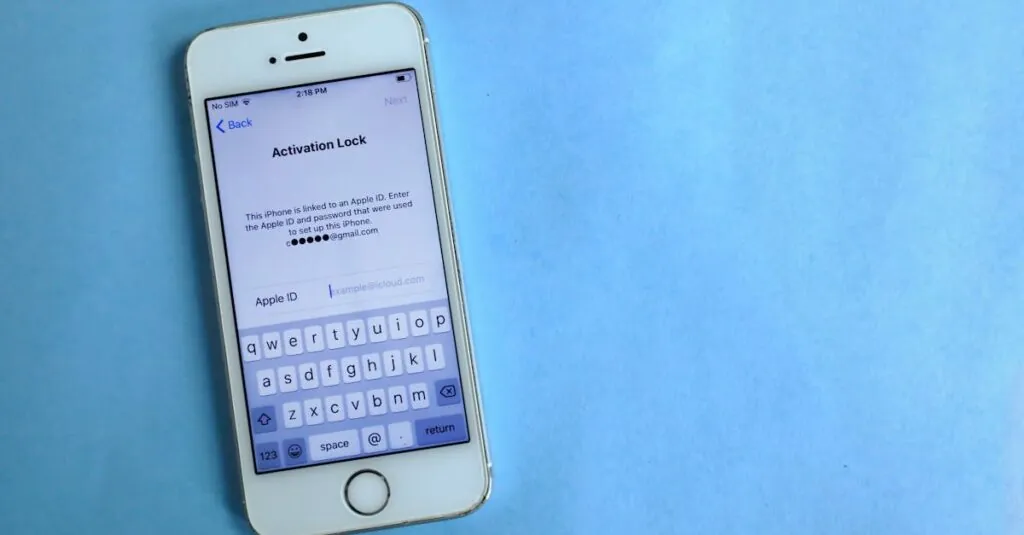Table of Contents
ToggleIn a world where distractions lurk around every corner, locking your iPhone screen is like putting on a superhero cape for your focus. Whether you’re dodging unsolicited selfies or the latest cat video, knowing how to lock that screen can save the day.
Imagine this: you’re in the middle of a serious conversation, and suddenly, your phone decides it’s the perfect time to showcase your embarrassing photos. Yikes! Fear not, because mastering the art of screen locking is simpler than finding a Wi-Fi signal. With just a few taps, you can keep your private life private and your phone safe from rogue fingers.
So let’s dive into the quick and easy steps to keep your iPhone screen locked and your sanity intact. Who knew security could be this effortless—and a little fun too?
Understanding Phone Screen Lock
Locking the phone screen serves as a fundamental step in protecting personal information and enhancing focus. Privacy becomes paramount in avoiding unintended notifications or app displays during conversations. A locked screen prevents unauthorized access, ensuring only the owner can view sensitive data.
Users benefit from several options when setting up screen locks. For instance, using a passcode provides a straightforward method to secure the device. Alternatively, biometric features like Face ID or Touch ID offer quick, convenient access while maintaining security.
Locking the screen, however, doesn’t just protect data. It also helps reduce distractions. Notifications receive attention only when the user chooses to engage with them. Setting specific times to check notifications allows for uninterrupted periods focused on tasks.
Understanding the various screen lock options requires familiarity with device settings. Exploring the settings menu reveals preferences for passcodes, biometric authentication, and auto-lock timer adjustments. Customizing these settings offers personal control over how the device behaves.
Maintaining a locked phone screen can become a habit. With practice, locking the screen becomes second nature, creating a more structured environment. Implementing this simple action can significantly improve both focus and security.
Mastering phone screen lock features extends beyond mere convenience. It enhances privacy, reduces distractions, and strengthens security. Prioritizing these practices illustrates the importance of safeguarding personal information in a digital age.
Different Methods to Lock Your iPhone Screen
Various methods exist for locking an iPhone screen, providing users with flexibility based on their preferences.
Using the Side Button
Pressing the side button enables quick screen locking. This simple action immediately turns off the display. Users can find the side button on the right edge of the device. Ensure you press it once; double pressing may activate Siri or other features. Upon pressing, the screen will lock, and notifications will cease. This approach works for any iPhone model that features a side button.
Using AssistiveTouch
AssistiveTouch offers an alternative for locking the screen, especially for those with accessibility needs. Activating AssistiveTouch allows users to access a virtual home button on the screen. Users can enable AssistiveTouch in the Accessibility section of settings. Once activated, tapping on the AssistiveTouch button opens a menu. The option for locking the screen appears within this menu, streamlining the locking process. This method enhances usability, ensuring anyone can conveniently secure their phone with ease.
Setting Up Auto-Lock
Setting up auto-lock on an iPhone enhances security and minimizes distractions. Users can customize how quickly their screens lock after inactivity.
Choosing Time Intervals
Selecting the auto-lock time interval defines how long the screen remains active before automatically locking. Options include 30 seconds, 1 minute, 2 minutes, 3 minutes, or 5 minutes. A shorter interval provides better security, while a longer duration offers convenience during tasks. Opting for 30 seconds is ideal for heightened security, especially in public spaces. Conversely, a 5-minute interval might suit those needing extended engagement without interruption. To adjust these settings, navigate to Settings > Display & Brightness > Auto-Lock. This customization allows users to find the right balance between accessibility and security.
Additional Security Features
Additional security features on iPhones enhance user privacy and convenience. They play a crucial role in safeguarding personal data.
Face ID and Touch ID
Face ID utilizes facial recognition technology for secure access. Users just need to glance at their device for instant unlocking. Touch ID allows for fingerprint recognition, facilitating quick access through the home button or side button. Both methods provide robust security, eliminating the need for passcodes. Users can enable either feature in Settings under Face ID & Passcode or Touch ID & Passcode. Enhanced security makes unauthorized access highly unlikely, ensuring personal information stays safe. Both options also streamline user experience by making it simple to unlock the device while on the go. With these innovations, iPhones prioritize security without sacrificing convenience.
Troubleshooting Common Issues
Locking an iPhone screen can sometimes encounter common issues. Users may find the side button unresponsive or the auto-lock settings not functioning as expected. Checking the side button functionality is crucial. If it feels stuck or doesn’t click, consider troubleshooting the button for potential repairs.
Another frequent issue involves auto-lock settings not working. Accessing Settings > Display & Brightness > Auto-Lock allows users to adjust the time intervals. If settings reset unexpectedly, it might result from a software glitch. Restarting the device often resolves minor software issues.
Face ID or Touch ID malfunctions can also occur. These security features may fail to recognize the user’s face or finger due to smudges or dirt on the sensor. Cleaning the camera or Touch ID sensor can improve recognition performance. Users should ensure their face is properly positioned within the frame for Face ID.
In cases where the screen locks unintentionally, settings adjustments may decrease this occurrence. Users can reevaluate their accessibility features, particularly if AssistiveTouch is activated. Disabling this feature temporarily might help determine if it’s causing erratic screen locking.
Lastly, if notifications appear despite the screen being locked, checking notification settings is essential. Navigating to Settings > Notifications will allow users to customize which apps can send alerts while the screen is locked. Limiting notifications enhances privacy and reduces distractions during important interactions.
Applying these troubleshooting steps helps ensure the iPhone screen locks effectively and consistently, providing a seamless user experience.
Locking the iPhone screen is essential for maintaining privacy and reducing distractions. By mastering the different methods available users can effortlessly secure their devices and protect personal information. Whether using the side button AssistiveTouch or adjusting auto-lock settings there’s a solution for everyone.
Taking the time to explore and customize these features not only enhances security but also creates a more focused environment. With practice locking the screen becomes second nature allowing users to engage with their devices on their terms. Embracing these simple steps can lead to a more structured and secure digital experience.




